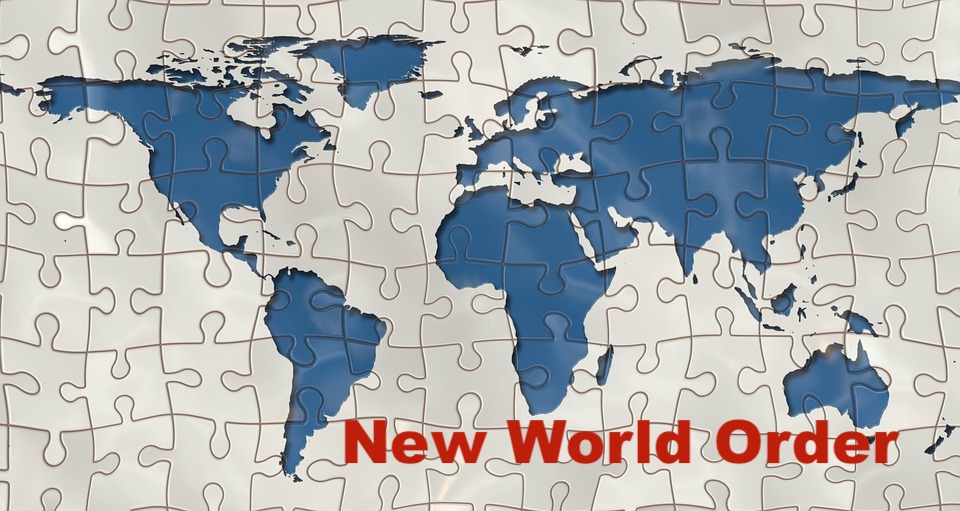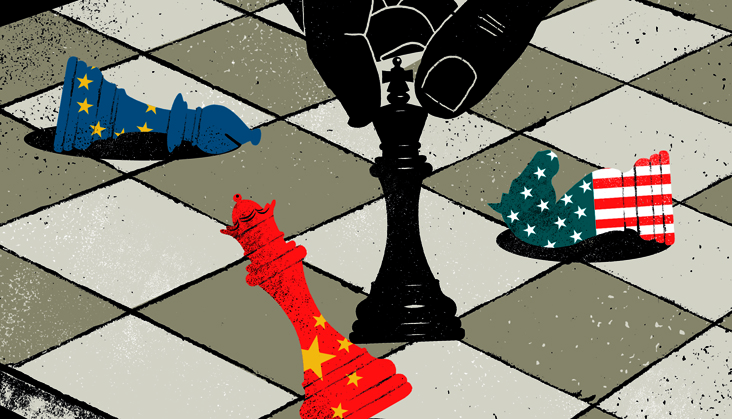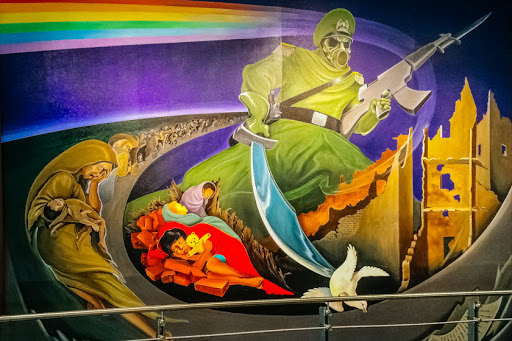The Fast-Approaching New World (Dis)Order
“What is at stake is more than one small country,” said President of the United States. “It is a big idea: a new world order.”
The phrase, “new world order,” was coined far in advance of its famed Presidential utterance by George W. Bush in 1991, quoted above.
 The following is taken from the book Game of Gods. (Game of Gods: The Temple of Man in the Age of Re-Enchantment, by Carl Teichrib, is a comprehensive investigation into the changing nature of Western Civilization, the replacement of the Judeo-Christian framework with a new, yet ancient paradigm. It is a journey into the cracks and crevices of big history; an expedition into the expanding realm of transformational movements and influential ideas – forces that are shifting how we think, behave, and relate.)
The following is taken from the book Game of Gods. (Game of Gods: The Temple of Man in the Age of Re-Enchantment, by Carl Teichrib, is a comprehensive investigation into the changing nature of Western Civilization, the replacement of the Judeo-Christian framework with a new, yet ancient paradigm. It is a journey into the cracks and crevices of big history; an expedition into the expanding realm of transformational movements and influential ideas – forces that are shifting how we think, behave, and relate.)
“The most thorough writing of our generation on the history and inner workings of the one-world movement.” – Gary H. Kah, author of The New World Religion.
On September 11, US President George Bush told Congress that America would “serve together with Arabs, Europeans, Asians and Africans in defense of principle and the dream of a new world order.”
It was the Persian Gulf crisis of 1990, and George H.W. Bush was in the Oval Office. On January 16, 1991, the day before Operation Desert Storm commenced, he contextually placed this military engagement within the framework of the United Nations:
“We have before us the opportunity to forge for ourselves and for future generations a new world order – a world where the rule of law, not the law of the jungle, governs the conduct of nations. When we are successful – and we will be – we have a real chance at this new world order, an order in which a credible United Nations can use its peacekeeping role to fulfill the promise and vision of the U.N.’s founders.”
Thirteen days later he said the following:
“What is at stake is more than one small country; it is a big idea: a new world order, where diverse nations are drawn together in common cause to achieve the universal aspirations of mankind – peace and security, freedom, and the rule of law. Such is a world worthy of our struggle and worthy of our children’s future.”
Many Americans were perplexed by this repeated phrase, new world order. Some commentators erroneously credited Bush as using it first. He certainly said it often, but others had used this phrase too.
President Reagan did in 1982, noting that all countries need to “strive together, motivated by the firm determination to build a new world order which guarantees political justice, economic justice, and social justice.”
In 1977 President Carter said, “the creation of that new world order demands bold initiatives and global solutions.” President Franklin D. Roosevelt employed it in the negative, describing Adolf Hitler’s global aspirations as “his new world order.”
For over a century before Bush’s presidency, social and political visionaries, diplomats, and heads-of-state have uttered those words.
And it nearly always meant the same thing: a new paradigm in international relations with a corresponding change in civilization – a global restructuring couched in some ideal of homogenization and interdependence.
This does not mean, however, that all who desire a new world order follow the same pattern or methodology or philosophy. How it is arrived at and what it entails can be nuanced. Nevertheless, it remains “a big idea.”
And it is an old idea.
In the 1600’s, Moravian Bishop Johann Amos Comenius “maintained that all men were citizens of the world” and should assemble “in one community under international law.”
William Penn called for a European Diet in 1693, in which nations would pool military resources against any state that refused to submit. In 1796, Carl J.A. Hofheim recommended an Assembly of European rulers to meet in a central, neutral city, and form a Perpetual Congress of Nations.
Thomas Paine argued for an Association of Neutrals, a grouping of countries using their combined naval strength to sanction aggressors, with ships of the Association sailing under a rainbow colored flag.
United States Senator Charles Sumner advocated for “a Congress of Nations with a high court” in 1849. Each was longing for a new world order, even though the phrase was not part of their lexicon.
The desire for a new order is normally associated with political and economic restructuring. This correlation is accurate, but a wider rearrangement is also envisioned.
 In the 1870s the founder of the Bahá’í faith, Bahá’u’lláh, spoke favorably of a coming new world order.
In the 1870s the founder of the Bahá’í faith, Bahá’u’lláh, spoke favorably of a coming new world order.
John Ferraby, a respected Bahá’í leader from the last century, fleshed out what this entails: a “world executive, backed by an international force,” a World Parliament and a global tribunal, “a uniform and universal system of currency,” collective security, a universal language, and a worldwide system of inter-communication – “embracing the whole planet, freed from national hindrances and restrictions.” Science and faith would merge, religions would harmonize, East and West would unite.
A “most great peace” would prevail on Earth.
A managerial city was pictured: “A world metropolis will act as the nerve centre of a world civilization, the focus towards which the unifying forces of life will emerge and from which its energizing influences will radiate.”
The Bahá’í International Community, which deliberates with the UN on global governance agendas, understands the connection between world order and the social acceptance of oneness,
“Laying the groundwork for global civilization calls for the creation of laws and institutions that are universal in both character and authority. The effect can begin only when the concept of the oneness of humanity has been wholeheartedly embraced by those in whose hands the responsibility for decision making rests, and when the related principles are propagated through both educational systems and the media of mass communications.”
Faith in Hague
The allure of world order has excited luminaries and pragmatists alike with its promise of administrative salvation.
In 1889, the first organizational model was established, the Inter-Parliamentary Union (IPU), bringing together parliamentarians from different nations.
International arbitration as the means of securing order was the goal.
At the first Hague Peace Conference in 1899, national governments, enraptured by the prospects of a new century, established the Permanent Court of Arbitration.
Confidence soared as international law was on the agenda. Peace would come through judicial decisions, birthing the IPU vision.
Intensely joyful by what happened in Hague, Andrew Carnegie, a believer in the directed evolution of society, became a proselytizer for this new faith in world order.
At the same time he knew the Court of Arbitration could not stand-alone; it would require a larger political structure and the engagement of civil society.
Giving an address at St. Andrew’s University in 1905, he proposed a League of Peace and encouraged the students – and all universities and churches and professionals – to unite in this “holy work.”
The sure path to peace would come through international arbitration, backed by a League who would isolate offending nations and, if necessary, use collective force to maintain discipline.
Social and cultural leaders, enamored by this newfound faith in cooperative human destiny, would need to act as prophets and saints – pointing the way for others to follow and providing moral legitimacy for its broader acceptance.
“Progressive men in the Old World and New are actively supporting the direct movement for the political unity of the world,” penned Raymond Bridgman in 1905.
A member of the American Peace Society, Bridgman had petitioned lawmakers for world organization. His was an intoxicating optimism in a vast coalescence, predicting a utopia so grand as to surpass all of history.
“First and greatest, there would be realized the political self- consciousness of mankind, hitherto never achieved. The world, unified and intelligent, would for the first time in human history come to the grandeur of its existence as one, and would feel the thrill of intelligent unity as it first said ‘I’ of itself…
When it shall have been attained the united race, knowing its unlimited powers, looking over the earth and recognizing its directorship amid all the forces of nature and man, feeling its strength and realizing its boundless opportunity, will say ‘I will.’
Thus and then would be accomplished the grandest revolution in human history. The world would have found itself, would have come into self-consciousness, realized its true supremacy, and discerned its opportunity. It would be thenceforth and forever a new being. All the preceding centuries, it is hardly exaggeration to say, would count for almost nothing in the existence of mankind as an organic whole.”
Less hubristic but still politically ostentatious was Theodore Roosevelt’s advocacy of world federalism during his 1910 Nobel lecture. His desire too was for a League of Peace, built upon the model of American federalism and the Hague process.
Roosevelt ended his lecture by saying:
“The ruler or statesman who should bring about such a combination would have earned his place in history for all time and his title to the gratitude of all mankind.”
During this same period the US House of Representatives considered a resolution to combine the navies of the world. Congressman Richard Bartholdt notified his colleagues:
“The work of world organization or world federation was auspiciously begun by the creation of the Hague court, and we do not propose to have it stop there, but must insist that modern conditions which impress all with the absolute interdependence of nations imperatively demand its early completion.”
And in Hague, Carnegie erected his magnificent Peace Palace – a “Temple of Peace” – with the resolute belief in a great and glorious universal brotherhood of nations.
Peace on Earth would come at last.
Kingdom by League
When the Great War ripped through Europe, starting in 1914, internationally minded men recognized an opportunity within the crisis.

A catastrophe of this magnitude required a post-war restructuring of global proportions.
Nicholas Murray Butler, then President of Columbia University and the person most responsible for convincing Andrew Carnegie to establish his Endowment for International Peace, voiced his support for a new order in response to the world conflict.
Speaking to the New York Times in 1914 on the subject of a “United States of Europe,” Butler announced:
“…the time will come when each nation will deposit in a world federation some portion of its sovereignty for the general good. When this happens it will be possible to establish an international executive and international police, both devised for the especial purpose of enforcing the decisions of the international court.”
Approximately one year later Butler gave an address to the Union League of Philadelphia, highlighting an envisioned new world order:
“The old world order changed when this war-storm broke. The old international order passed away as suddenly, as unexpectedly, and as completely as if it had been wiped out by a gigantic flood, by a great tempest, or by a volcanic eruption. The old world order died with the setting of that day’s sun and a new world order is being born while I speak.”
Butler, who had personal access to ki
ngs and presidents and prime ministers, understood the enormity of the change being forced upon all by the circumstances of the war.
“It is essentially a war for a new world,” the citizen diplomat wrote. “It is a war for a new international world.”
Teddy Roosevelt pontificated on this theme. He recommended that “the efficient civilized nations – those that are efficient in war as well as in peace” band together in a “world league for the peace of righteousness.”
“What I propose,” he explained, “is a working and realizable Utopia.”
In New York City’s Century Club a small group of eminent men who regularly dined together came up with an idea: a league to impose world peace.
In time this fellowship evolved into a committee led by former US President William Taft, a member of the original dinner group.
The League to Enforce Peace (LEP) was birthed: “A world organization which will tend to prevent war by forcing its members to try peaceable settlement first.”
Essentially the League was to focus on arbitration as a way to resolve disputes between nations.
However, if judicial mediation failed to bring resolution, the League would rally its members to engage in collective measures, particularly economic boycotts and blockades.
If needed, the League could employ joint military action against a non-compliant country. Prominent editors, lawyers and judges, university presidents and other influencers rallied around the cause.
John B. Clark, Professor of Political Economy at Columbia University and a League to Enforce Peace executive member, stated that “the world demands a league of some kind for preserving peace and, for the first time, much of the world expects to get it.”
At the League’s 1916 conference, President Woodrow Wilson would not directly commit to the LEP scheme, but avowed a “creed,” a “great consummation… when coercion shall be summoned not to the service of political ambition or selfish hostility, but to the service of a common order, a common justice, and a common peace.”
Wilson ultimately chose a different path of internationalism, the more organic approach of parliamentarianism.
Frederick Lynch, a Social Gospel minister who was part of the dinner group at the Century Club and a figure within Carnegie’s Church Peace Union, worked to bring clergy around to the idea of world order as a high Christian duty.
Because he was intimately involved with the Federal Council of Churches (FCC), Lynch was effective in raising the FCC’s stature as a progressive voice for world federal authority.
Taking cues from scientific pragmatism and Positivism, the force of Spinoza and Liberal Theology, the Social Gospel movement sought a managed evolution to collective betterment – a so-called process salvation claiming to be leading to a humanized Kingdom of God on Earth.
Thus, Lynch’s 1916 book, The Challenge: The Church and the New World Order, recommended that Christians band together “and form a compact, or league of nations, or some sort of united nations of the world.”
Another noted clergyman, American Baptist minister and Social Gospel campaigner, Samuel Zane Batten, likewise pushed for a new civilization.
Similar to Lynch, Batten placed this “big idea” within a Christian calling. Consider what he said in his 1919 book, The New World Order:
“If there is to be a new world it must come first of all through a new spirit in the nations. There must be created an international mind and conscience; men must learn to think of humanity as one family and to have a world patriotism; they must keep their minds free from jealousy and selfishness, and base their policy and practice upon true and Christian principles; they must be quick to resent injustice by a nation as by an individual.
Humanity must become an ideal in order that it may become an actuality. World patriotism must be a faith, a chivalry, before it can be an organization. International peace must become an aspiration, a religion, before it will become a reality… There must be some international organization which shall make the new ideas effective and secure world justice.”
Social Gospel ministers believed that the intrinsic goodness of humanity could be democratically unlocked nation-by-nation.
The Brotherhood of Man would be realized and empowered through righteous internationalism.
Heaven on Earth would manifest as mankind embraced political deliverance, for the “fundamental defect is with society itself.” Batten therefore called for a “league of free nations, a federation of the world.”
The political Temple of Man – a global parliament, an international court, and a world police force – would usher in the Kingdom.
yogaesoteric
May 26, 2021
